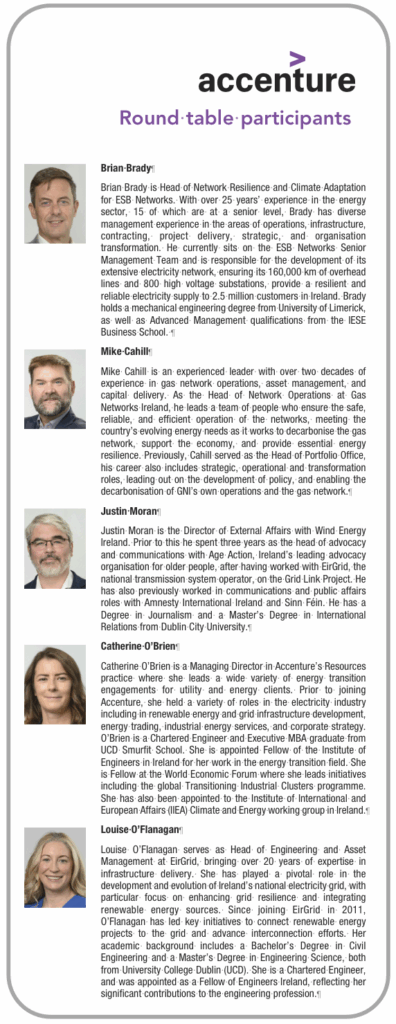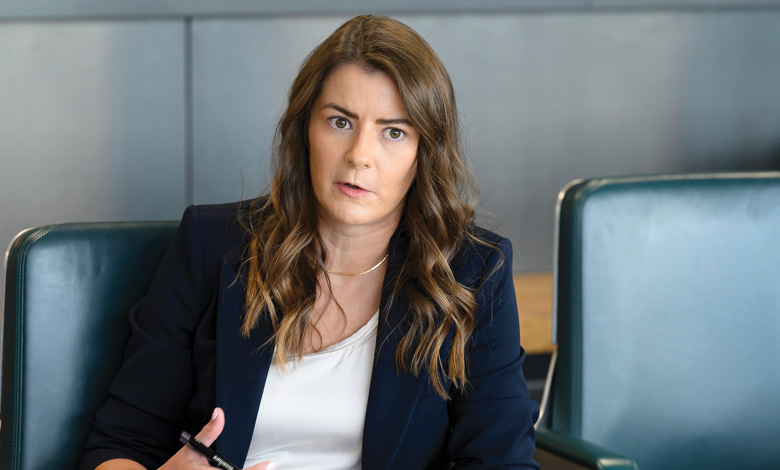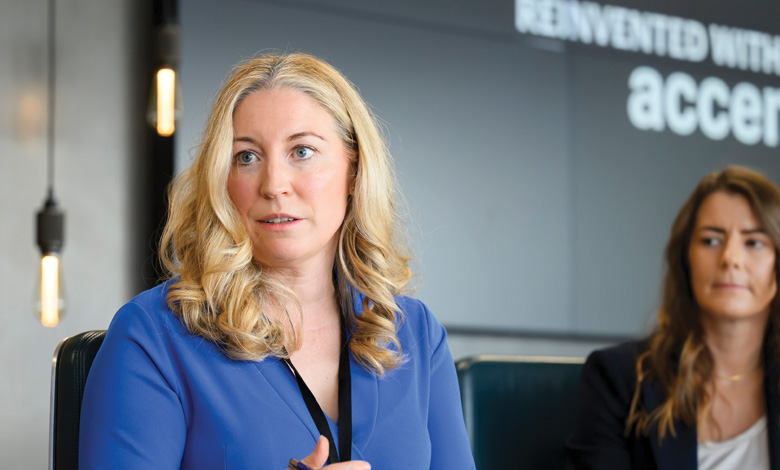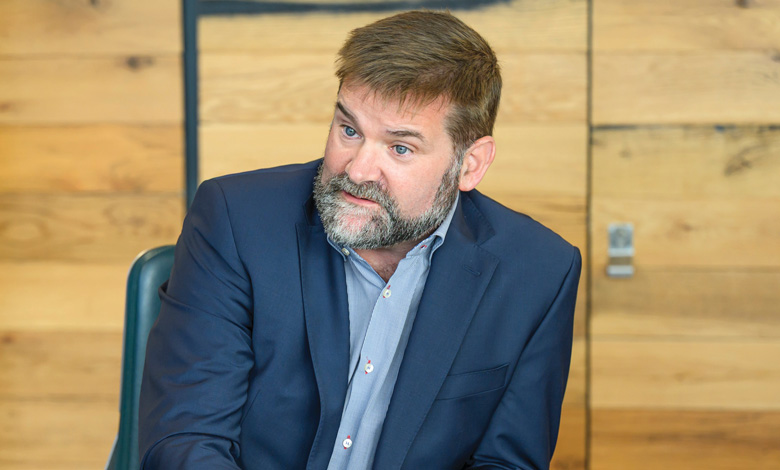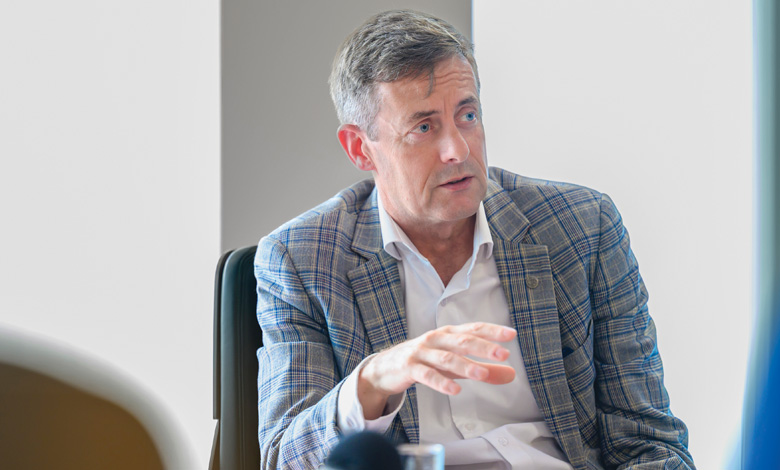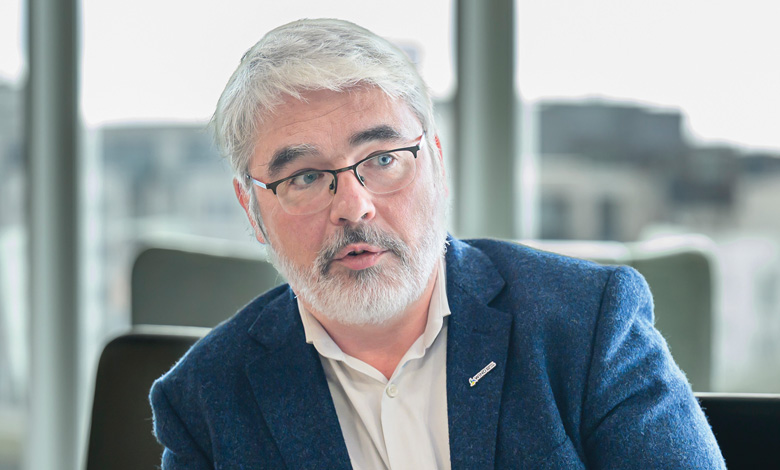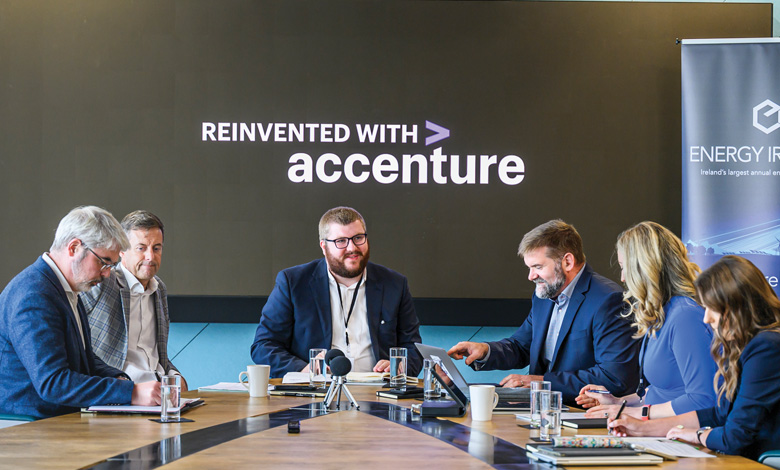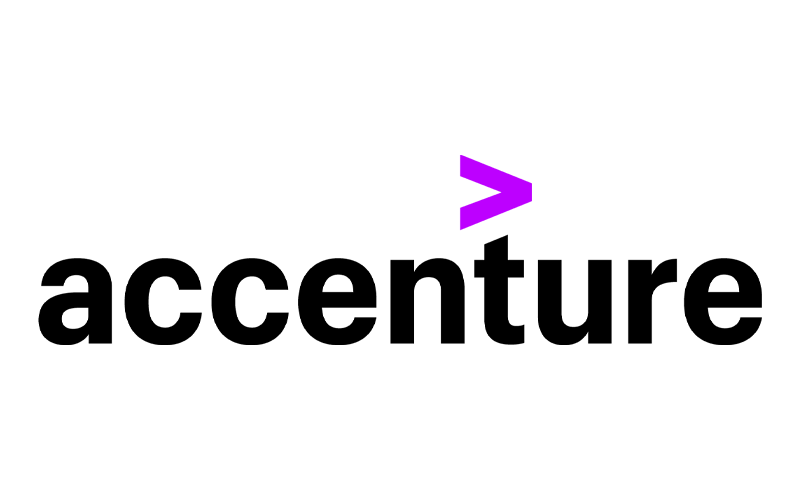
Navigating the EU’s energy transition
14th October 2025
Rolling out alternative fuels
15th October 2025Round table discussion: Infrastructure resilience
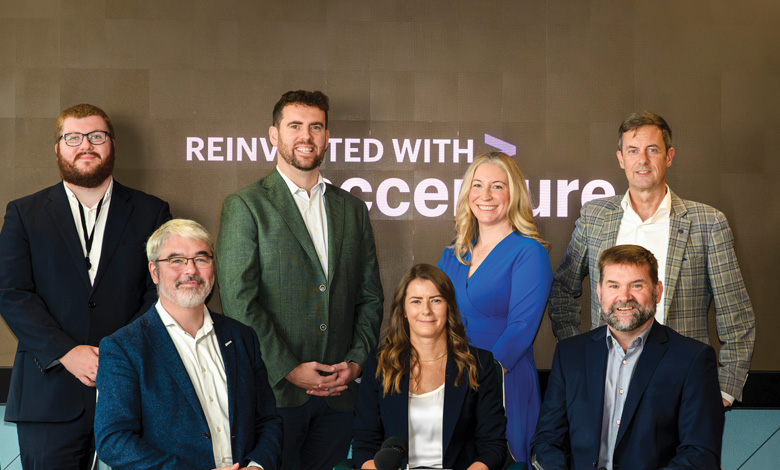
Accenture hosted experts from across the energy sector for a round table discussion on infrastructure resilience.
What does ‘resilience’ mean from your or your organisation’s perspective in terms of energy infrastructure?
Catherine O’Brien
Resilience, long taken for granted, has become a national focus in light of more frequent and intense weather events and cyber-attacks. Utilities face an unprecedented challenge to improve resilience and deliver on energy transition goals while facing growing demand, skills shortages and the need to reinvent digital approaches; and all in compressed time-frame. Resilience presents a pivotal socioeconomic opportunity, and harnessing it demands a coordinated enterprise-wide approach to strengthening commercial, people, operational, sustainability and technology capabilities. Accenture’s research shows that more resilient organisations achieve higher financial performance. This is vital to generate capital for infrastructure reinvestment, and even more important for the reputation of semi-state organisations in a local and international context.
Louise O’Flanagan
As the electricity grid rapidly evolves to meet the needs of our growing economy and society, we need have a secure and resilient grid. It needs to be able to withstand the impact of threats, such as storms, and reliable enough so that there is minimal downtime. The grid is becoming increasingly complex as we integrate more renewables, energy storage, and introduce sophisticated digital systems and operational changes. We’re working with Government and stakeholders to progress and deliver essential infrastructure projects to ensure the grid is resilient and connect renewables.
Mike Cahill
Ireland’s gas network is one of its most strategically important and relied-upon national assets. Every year, our network transports almost a third of the national primary energy requirement. The gas network is dependable and flexible, delivering 100 per cent availability during recent weather events such as Storm Éowyn. A core priority for us is to safely maintain and develop our network, to assure reliable delivery of energy, keep pace with growth in demand and enhance resilience. We continue to enhance cyber and physical security defences to protect against ever-increasingly sophisticated threats. The gas network is at the heart of the Irish energy system and is a flexible and responsive backup to intermittent renewable energy sources like wind and solar.
Brian Brady
Network resilience begins with the customer and what you are seeking to achieve for them. It is about how to reduce the impact of an abnormal event and the pace of recovery from it, minimising the effect on homes, farms and businesses. We have been planning and delivering grid infrastructure resilience for years but the predicted scale of events is growing and our Price Review Six (PR6) plans, submitted in November 2024, includes for a doubling of investment in infrastructure resilience. Infrastructure resilience is a continuous multiyear process, influenced by both climate mitigation and climate adaptation which are two sides of the same coin.
Justin Moran
A stable, reliable grid directly correlates with economic resilience. Electricity prices in the EU are two to three times higher than the US or China. Within the EU, Irish electricity prices are amongst some of the highest. We are seeing what was a very successful free market-based economy facing tariffs and rising supply chain pressures, making us acutely vulnerable. We must make the energy system reliable, resilient, and affordable for customers. The Draghi report from September 2024 finds that Europe has become uncompetitive. However, a significant degree of the solution is in our hands. If we can deliver and build more renewable energy infrastructure, we can make the grid more resilient, and in turn, achieve economic resilience.
How are resilience risks evolving and how is your organisation/industry responding?
Justin Moran
Supply chain resilience is one of the most acute risks facing Ireland; ensuring that the complicated parts we need to build windfarms are in steady supply at an affordable price. There is a serious challenge in Europe about the viability of European wind part manufacturing as a competitive industry, further complicated by the potential cybersecurity risks associated with importing Chinese manufactured material. If policymakers want to take these challenges on, they make need to accept higher prices than would be the case with importing supply chain components from outside Europe.
“Innovation and harnessing advances in digital technology is critical to ensuring resilience.”
Catherine O’Brien
Catherine O’Brien
There is limited visibility and transparency through end-end supply chains, meaning there are significant risks to delivery of energy transition and resilience goals as Justin mentioned. Accenture’s research shows that only 50 per cent of organisations have visibility of more than half of their tier one supply chain, and only 20 per cent of organisations have visibility of more than half of their tier two. Risk and complexity increase through the tiers. To de-risk and develop agile, robust supply chains, real time data insight, advanced scenario modelling and decision support tools harnessing Generative AI capabilities will be fundamental.
Brian Brady
The supply chain is also fundamental for us at ESB Networks. Consider the two timeframes of medium term and short term. The first is with PR6, where we have developed and adapted our supply chain strategy to give us the volume of material needed to meet both decarbonisation and network growth challenges while having a depth in our supply chain across multi providers over the medium term. The second factor, as we saw with Storm Éowyn, relates to strategic spares ensuring that we do not run out of material during such emergency restoration works. Having a resilient supply chain is critical for when you have high peaks in a very short period of time. Key to this for us is about diversifying our supply sources and diversity in use of materials.
Louise O’Flanagan
Because of the challenges around supply chains, trade-offs often have to occur around cost and lead time. However, there are also challenges around long-term support available from that supply chain. For example, when you look at assets going onto the transmission system, we are looking at a lifetime of around 50 years and the consideration needs to be given to how these assets will be supported into the future. We have to look at the market and also how the skillset to support these needs will be supported within Europe. There is also a challenge with transport; if we are transporting material from outside Europe, we have to account for geopolitical risk in some parts of the world, and having a diversification of sources for each part of your supply chain is a strong means of mitigating this risk.
Mike Cahill
Building capacity and capability in our supply chains is a key focus for us. Delivery of gas related infrastructure projects in Ireland is dependent on a relatively narrow supply base who have the necessary record of accomplishment and skill set to deliver our requirements. We are addressing this through extensive market engagement, seeking to expand relationships with UK and European suppliers. Five years ago, malicious damage to our sub-sea pipelines was considered improbable, however, with the growing unease in geopolitics, we have invested to became members of a Pipeline Repair and Subsea Intervention group which guarantees equipment availability times as well as specialist resources should we need to respond to an incident involving our sub-sea assets.
What lessons have past disruptions taught us, and how can recovery be improved?
Mike Cahill
Disruptions have shown that having robust contingency plans in place is crucial for minimising impact and ensuring a swift recovery. We test our Natural Gas Emergency Plan (NGEP) annually through participation in the National Emergency Coordinator (NEC) emergency exercise in the UK and their comparator in Northern Ireland. The gas network is dependable and flexible, that said, there are always opportunities to improve. Investment is core to infrastructure resilience and for Price Control Six (PC6), we need to ensure allowances are sufficient to support the investment required, however, these financial requirements need to be balanced with keeping energy affordable for gas consumers.
“Resilience is about risk management and risk assessment.”
Louise O’Flanagan
Louise O’Flanagan
The transmission system held up fairly well during the events of Storm Éowyn, and I think that is important because extreme weather events will continue, they will become more severe, and they will become more frequent. This is because of its size and strength, as well as significant reinforcements made over the last few years and ongoing maintenance works. If we can optimise maintenance practice, have reliable supply chains which allow component parts to be replaced quickly, and manage things like vegetation, these hold the keys to ensuring resilience into the future. Improved interconnection with the UK via Greenlink, which is now operational, and with France via the Celtic Interconnector which is being constructed at present, will also allow us to improve our resilience. Weather phenomena which may be taking place in Ireland may not apply in France in the same way.
Justin Moran
The two big disruptions this country has faced over the last decade have been Brexit and the Covid-19 pandemic. They are the only two examples I can think of where the Government acted as one and had all parts of it moving in the same direction and where every aspect of government was working towards the same goal. We are trying to transform how the Irish energy system works and how it is delivered. That requires the input of many government departments, so I think that drawing on lessons from previous national priorities and emergencies, we have shown that if government treats something with priority, then all the component parts of government can move in the same direction with a focus on what our national priority is.
Brian Brady
At ESB Networks, we are in the space of the ‘three Cs’: collaborate, communicate, and coordinate. Ireland is very well-connected even though we sit on the edge of western Europe. We collaborate closely with our European colleagues, sharing best practice in the resilience space, indeed we lead the eDSO working group on resilience. At home, coordination is going well in Ireland with the structures the Government is putting in place such as the National Adaptation Framework, the work of the National Climate Change Risk Assessment and Sectorial Adaptation Plans. These point to the level of cross agency collaboration and coordination and how we respond. During disruptive events, the National Emergency Co-ordination group (NECG) structures work very well and we saw that with a whole-of-government response to Storm Éowyn. In terms of learnings, we have seen how resilience is for all assets and not just infrastructure. In Éowyn we saw how forestry owners were affected by the storm with around 24,000 hectares of forest stock windblown and suffered with €500 million of investment at risk. We must ensure that we improve the resilience of all assets for extreme weather events.
“The gas network is dependable and flexible, that said, there are always opportunities to improve.”
Mike Cahill
Catherine O’Brien
Globally we have seen an increase in hybrid attacks. Offshore infrastructure such as wind farms and subsea cables is increasingly targeted by hybrid attacks; a growing concern for Ireland as an island with one of the largest sea areas in Europe. Cybercriminals are also using climate events and natural disasters as opportunities to exploit heightened vulnerabilities. During the wildfires in California, phishing attacks posing as relief donations were widespread along with attacks on utilities already strained by the wildfires. Holistic threat modelling and a portfolio planning approach to resilience at organisation and national level is critical to prepare for hybrid attacks.
Looking to the future, is there an opportunity to enhance the resilience of national critical infrastructure?
Brian Brady
In short, yes. The predictions are that future storms will become more extreme. Storm Éowyn certainly has set the new frame of reference for the scale and severity of a climate change wind event. Éowyn has had double the impact of any previous event such as Darragh, Darwin, or Ophelia. All aspects of our critical infrastructure resilience – water, wastewater, communications, electricity, et cetera – were well-tested during Storm Éowyn. The lessons from that for all critical infrastructure are still being worked through. We work closely with all critical infrastructure providers and we continue to support them with their risk assessment enabling them prioritise their installation of back-up generation at key sites.
“Infrastructure resilience is a continuous multiyear process, influenced by both climate mitigation and climate adaptation.”
Brian Brady
Louise O’Flanagan
Our costs are approved and overseen in five-year periods through the CRU’s Price Review process. As part of this process, we submitted a plan for the PR6 period of 2026-2030 against a backdrop of objectives laid down by Government and the CRU. PR6 represents a timely opportunity to invest in Ireland’s future as we work to support and facilitate the timely delivering of an unprecedented amount of new infrastructure. We have over 370 projects that we want to deliver over the next number of years which will enhance the grid, it will enhance existing infrastructure by both replacing older assets on the grid and building new infrastructure. All of this supports the ambition of a more resilient grid.
Catherine O’Brien
Innovation and harnessing advances in digital technology is critical to enhancing resilience. As complexity grows and disruptions intensify, investing in asset intelligence, advanced scenario analysis, decision support and automated response tools leveraging generative AI is fundamental. Accenture’s research finds that rapid AI adoption has dramatically accelerated the speed, scale and sophistication of cyber threats, far outpacing current enterprise cyber defences. Deploying generative AI can scale security capabilities, strengthen cyber defences and detect threats earlier. Upskilling the workforce to adopt these tools will be critical to balancing the demands of day-to-day operations, long term resilience and energy transition goals. Accenture has launched LearnVantage to help our clients to quickly identify technology driven skills gaps and to provide industry-specific training at speed and scale.
Mike Cahill
In line with Action 17 of the Energy Security in Ireland report, Gas Networks Ireland has been tasked with evaluating delivery mechanisms for a state-led Strategic Gas Emergency Reserve (SGER). This initiative is a critical transitional measure to safeguard Ireland’s energy resilience as the country accelerates its transition to large-scale renewable energy. We are also members of the EU Horizon funded project VIGIMARE which we believe has the potential to greatly improve our resilience against malicious damage to our sub-sea pipelines, which are being used as a demonstration case for the technology. In a BAU context, the ‘five Rs’ of reliability, resistance, redundancy, recovery, and redundancy are the corner stones of resilience, which is the frame of reference for our capital and operational work programs.
Justin Moran
Every project that we have earmarked will have to go through the planning system. The Draghi report finds that Ireland has the slowest planning system in the European Union for the delivery of wind farms. This also applies with solar. The Department of Housing has introduced a new statutory instrument to speed up the delivery of the Renewable Energy Directive III, which will hopefully be useful. This will also massively increase the workload on An Coimisiún Pleanála and the National Parks and Wildlife Service which are already under-resourced. The CRU is also not well-resourced enough to do its existing role, and yet it is about to be responsible for private wires legislation. State agencies involved in the energy transition and beyond are under-resourced; they do not have the resources to bring in AI and the other opportunities which could increase our advantages. Part of the solution to this from a Wind Energy Ireland perspective is the introduction of a state climate recruitment fund where we invest in the basic needs that each organisation can play in the energy transition. Through this, we can recruit the people with the skills and expertise that will allow us to expedite delivery and enhance resilience.
“A stable, reliable grid directly correlates with economic resilience.”
Justin Moran
What approach should we adopt to monitor and anticipate future disruption risks and how do we know we are on the right track?
Brian Brady
When we emphasise resilience, there is a risk that climate adaptation will become the sole focus and climate mitigation will take second place. When we consider the devastation of Storm Éowyn, caused by our current greenhouse gas (GHG) emissions, we need to ask ourselves the question how devastating will future storms be with higher GHG emissions? What investment in infrastructure resilience will be required to combat such weather events in the future? The more effectively we deliver on climate action plans now, the better we offset climate adaptation and the less investment we need in further resilience infrastructure. It is crucial that we address the origin of the problem and not just the symptoms. The delivery of climate action plans will be the measure of our progress in this regard.
Mike Cahill
Consider the creation of a central coordinating authority for critical infrastructure, modelled on the EU’s Projects of Common Interest (PCI) framework to align planning, environmental, and regulatory processes. This authority could enforce statutory timelines, apply a programme management approach, and ensure accountability across agencies in the delivery of infrastructure core to our energy resilience. Neither can we afford to reinvent the wheel and must improve our ability to leverage what has been successfully done in France, Italy, Denmark, and other EU countries for example in supporting biomethane production. Denmark is currently meeting over 40 per cent of its gas demand from biomethane.
Louise O’Flanagan
Resilience is about risk management and risk assessment. There are different approaches to both across organisations, so it is important that they are harmonised. This is to avoid a situation where you develop a solution which may not yield what you need it to. It is also difficult to determine if we are on track as risks are evolving. Therefore, it is useful to regularly simulate cyber-attacks and extreme weather events as scenario planning keeps everybody focussed.
Justin Moran
We must determine how we will inform Irish customers and businesses about the fact that resilience is partly in their control. This relates to the decisions they make regarding where they live, how they live, and the energy systems they use. They can be a part of this process which must be bottom up as well as top down where individual consumers can be supported, educated, and empowered to make decisions to make the energy system more resilient.
Catherine O’Brien
It is crucial that we adopt a portfolio approach to infrastructure resilience underpinned by a shared understanding of risk tolerance, investment priorities and outcomes across government, utilities, industry, and society. Engagement is key and we must ensure citizens understand the system value of resilience and the investment required. International benchmarking and the implementation of industry standards and regulations is critical to measure progress.

